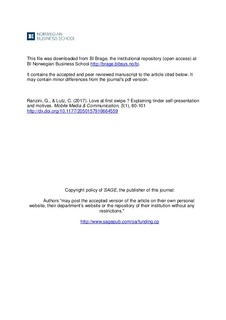Love at first swipe ? Explaining tinder self-presentation and motives
Journal article, Peer reviewed
Permanent lenke
http://hdl.handle.net/11250/2432285Utgivelsesdato
2017Metadata
Vis full innførselSamlinger
- Scientific articles [2181]
Originalversjon
Mobile Media and Communication, 5(2017)1, 80-101 http://dx.doi.org/10.1177/2050157916664559Sammendrag
The emergence of location-based real-time dating (LBRTD) apps such as Tinder has introduced a new way for users to get to know potential partners nearby. The design of the apps represents a departure from “old-school” dating sites as it relies on the affordances of mobile media. This might change the way individuals portray themselves as their authentic or deceptive self. Based on survey data collected via Mechanical Turk and using structural equation modeling, we assess how Tinder users present themselves, exploring at the same time the impact of their personality characteristics, their demographics, and their motives of use. We find that self-esteem is the most important psychological predictor, fostering real self-presentation but decreasing deceptive self-presentation. The motives of use—hooking up/sex, friendship, relationship, traveling, self-validation, and entertainment—also affect the two forms of self-presentation. Demographic characteristics and psychological antecedents influence the motives for using Tinder, with gender differences being especially pronounced. Women use Tinder more for friendship and self-validation, while men use it more for hooking up/sex, traveling, and relationship seeking. We put the findings into context, discuss the limitations of our approach and provide avenues for future research into the topic.
Beskrivelse
The accepted and peer reviewed manuscript to the article
